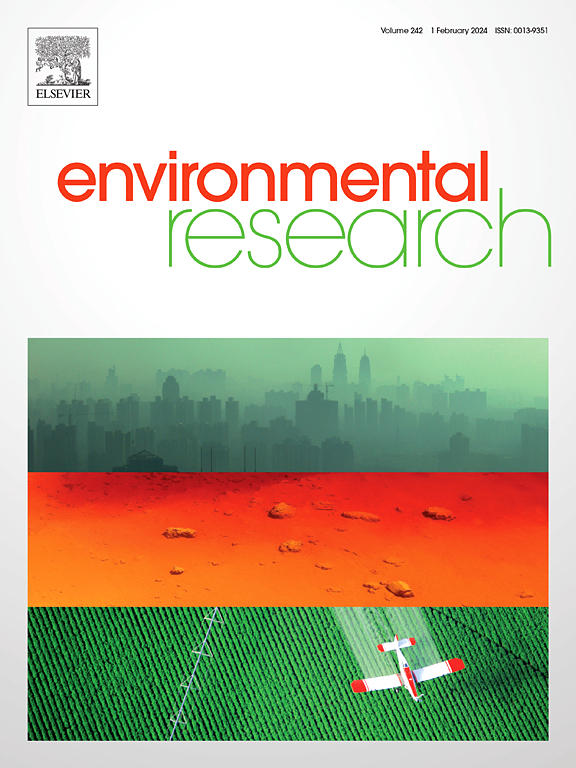使用斜沸石填料的循环固定床光生物反应器(CFBP)的开发和性能评估,以增强尿液中微藻的培养:机理见解。
IF 7.7
2区 环境科学与生态学
Q1 ENVIRONMENTAL SCIENCES
引用次数: 0
摘要
尿液是生活废水中氮和磷的主要来源,由于高氨氮浓度和盐度,对微藻处理提出了挑战;因此,在使用传统的光生物反应器时,需要额外的处理。为解决上述不足,本研究开发了一种新型的斜沸石循环固定床光生物反应器(CFBP),采用三级运行模式。在CFBP系统运行过程中,出现了斜发沸石循环处理(模式1)、微藻悬浮培养(模式2)和微藻-斜发沸石循环培养(模式3)模式。结果表明:经斜发沸石处理后,模式1合成尿氨氮浓度由1793.85 mg/L降至129.03 mg/L,盐度由1.22%降至0.62%;此外,通过离子交换引入一些有益离子(如Ca2+、Mg2+和Fe3+),有利于微藻在模式2和模式3下的生长。载尿成分的斜发沸石可作为微藻培养模式3的缓释剂。在两种模式(模式2和模式3)结束时,微藻生物量浓度分别达到1.09 g/L和1.03 g/L,细胞内脂质和色素积累,可作为进一步加工的原料。三维激发-发射矩阵(EEM)数据分析揭示了微藻在操作过程中引起的腐植酸样物质积累。新型CFBP系统和三级模式为源分离尿液处理提供了一种创新的解决方案。该系统可以同时去除污染物和微藻生物质回收,促进废水的可持续管理和资源循环利用。本文章由计算机程序翻译,如有差异,请以英文原文为准。

Development and performance evaluation of a circulating fixed-bed photobioreactor (CFBP) with clinoptilolite fillers for enhanced microalgae cultivation in urine: mechanistic insights
Urine, a major source of nitrogen and phosphorus in domestic wastewater, challenges microalgae-based treatments due to high ammonia-nitrogen concentrations and salinity; therefore, additional processes are required when using conventional photobioreactors. This research developed a novel circulating fixed-bed photobioreactor (CFBP) with clinoptilolite and a three-stage operation mode to solve the above deficiencies. Modes including clinoptilolite cyclic processing (mode 1), microalgae suspension cultivation (mode 2), and microalgae-clinoptilolite cyclic cultivation (mode 3) occurred during the operation of the CFBP system. The results demonstrated that clinoptilolite treatment reduced the concentration of ammonia nitrogen (from 1793.85 mg/L to 129.03 mg/L) and salinity (from 1.22 % to 0.62 %) in synthetic urine of mode 1. Furthermore, some beneficial ions (e.g., Ca2+, Mg2+, and Fe3+) were introduced through ion exchange, which favored the microalgae growth in mode 2 and mode 3. Clinoptilolite loaded with urine components can be used as a slow-releaser for microalgae cultivation in mode 3. The biomass concentration of microalgae reached 1.09 g/L and 1.03 g/L at the end of two modes (mode 2 and mode 3), and the intracellular lipids and pigments were accumulated, which can be used as raw materials for further processing. The data analysis of the 3D excitation−emission matrix (EEM) revealed the humic acid-like substances accumulation induced by microalgae during operation. The novel CFBP system and three-stage mode provide an innovative solution for source-separated urine treatment. The system enables simultaneous pollutant removal and microalgae biomass recovery, advancing sustainable wastewater management and resource recycling.
求助全文
通过发布文献求助,成功后即可免费获取论文全文。
去求助
来源期刊

Environmental Research
环境科学-公共卫生、环境卫生与职业卫生
CiteScore
12.60
自引率
8.40%
发文量
2480
审稿时长
4.7 months
期刊介绍:
The Environmental Research journal presents a broad range of interdisciplinary research, focused on addressing worldwide environmental concerns and featuring innovative findings. Our publication strives to explore relevant anthropogenic issues across various environmental sectors, showcasing practical applications in real-life settings.
 求助内容:
求助内容: 应助结果提醒方式:
应助结果提醒方式:


